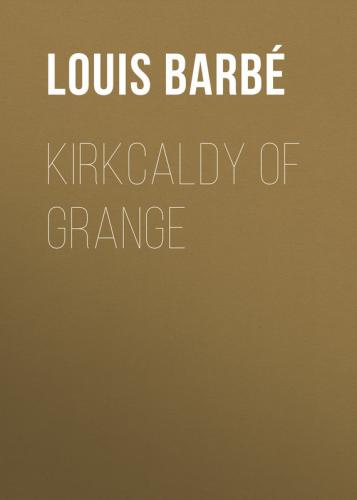Thus, on the 30th of July, 1547, ended the siege of the famous Castle. Entering it at once, the French ‘spoylled verrie rigorouslie.’ According to Pitscottie, ‘they gott both gold, silver, cloathing, bedding, meitt and drink, with all veapones, artaillie, and victuallis, and all vther plenisching, and left nothing behind thame that they might gett carried away in thair gallies.’ The ‘Diurnal of Occurrents’ estimates the value of the spoil at one hundred thousand pounds. By command of the Governor and Council, the Castle itself was razed to the ground. ‘Whether this was to fulfil their law, which commandeth places where cardinals are slain so to be used, or for fear that England should have taken it, as they did Broughty rock, we are uncertain,’ says Calderwood, who reports the fact.
IV. IN FRANCE
To Arran and his Council, the terms obtained from Strozzi by the rebel garrison seemed to be far too lenient; and they accordingly sent John Hamilton of Milburne to the King of France, who was now Henry II., and to the powerful Cardinal of Lorraine, urging them to repudiate the Captain-General’s action, and, in spite of the promises by which they had finally been induced to surrender, to handle the prisoners sharply.
Owing to circumstances which the chroniclers do not explain, the journey to France appears to have been unusually protracted; for, although Strozzi is said to have sailed from St Andrews about the middle of August, it was not till November that the galleys are reported to have reached Rouen. On his arrival, the six score Scotsmen whom he brought with him, learned that they were not to be given the option of entering into the service of France, or of passing, at the King’s expense, into any other country they might choose; and that the murder of Cardinal Beaton, and the subsequent rebellious defiance of the royal authority were not to be allowed to go unpunished. John Knox and Balfour, together with the prisoners of lower degree, were kept on the galleys as slaves, and sent to work on the Loire. Their fate was commemorated in the doggerel couplet given by Calderwood as the ‘song of triumph’ of the Papists: —
‘Preests, content you now; preests, content you now,
For Norman and his companie hath filled the galeyes fow.’
In reality, however, Norman Lesley, with the Laird of Pitmillie, and the Laird of Grange for his companions, was conveyed to Cherbourg. Henry Balneaves was imprisoned in Rouen itself, where he spent his enforced leisure in writing a ‘comfortable treatise’ on Justification by Faith without Works. James Melville was relegated to the Castle of Brest, but very shortly after ‘departed from the miseries of this life.’
To William Kirkcaldy, Peter Carmichael, Robert and William Lesley, what was then one of the most formidable fortresses in the kingdom, was assigned as a place of confinement.
Built on a huge rock of granite, in the blue, savage Norman Bay, there stood the imposing structure upon which the admiration of the Middle-Ages bestowed the name of the Wonder of the West. Situated some four miles from the nearest point of the mainland, it was guarded by the sea at high water, but became more inaccessible still when, for a couple of hours each day, the ebbing tide left nothing but a wide expanse of treacherous quicksands between it and the coast. This was the abbey-fortress of Mont Saint-Michel, that ‘wonderfully strong place upon the sea-shore,’ which had proved the bulwark of Normandy during the long struggle between England and France, and in which insignificant garrisons of determined men had, time and again, successfully held out against the assaults of beleaguering thousands. Here it was that the four Scottish prisoners were destined to spend many months of captivity. But the very fastness of their isolated prison was not without advantage for them. It inspired the Governor with such confidence that he deemed it unnecessary to deprive them of the restricted liberty that the rock afforded. The only annoyance to which they were submitted, was one which affected them through their religious opinions, and which they shared in common with the Scottish prisoners in other parts of the country. Knox relates that those who were in the galleys were threatened with torments if they would not give reverence to the Mass, and that they would have been compelled to kiss a statue of the Virgin, if one of them had not seized it and cast it into the Loire. At Cherbourg, too, the governor of the castle did his utmost to induce Sir James Kirkcaldy and his companions to attend Mass with him. When they refused to do so, he threatened to compel them; but they warned him that, if he chose to adopt such a course, they would, by their irreverent behaviour, let all present know their contempt for the ceremony. William Kirkcaldy, with his three fellow-captives, was subjected to the same importunities by the captain to whose keeping he had been entrusted at Mont Saint-Michel. With equal firmness, though in a more bantering tone, he replied for himself and for them, that ‘they would not only hear Mass every day but also help to say it, providing they might stick the priests; otherwise not.’
Конец ознакомительного фрагмента.
Текст предоставлен ООО «ЛитРес».
Прочитайте эту книгу целиком, купив полную легальную версию на ЛитРес.
Безопасно оплатить книгу можно банковской картой Visa, MasterCard, Maestro, со счета мобильного телефона, с платежного терминала, в салоне МТС или Связной, через PayPal, WebMoney, Яндекс.Деньги, QIWI Кошелек, бонусными картами или другим удобным Вам способом.
